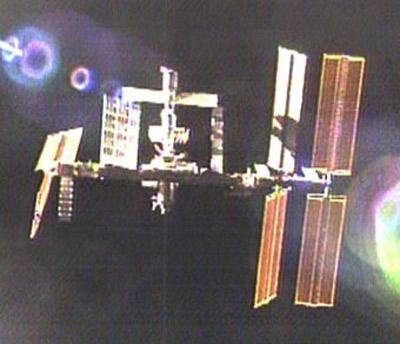Astronauts Scan Space Shuttle's Heat Shield

CAPECANAVERAL - The seven astronauts on board the space shuttle Discovery scanned their spacecraft's heat shield for potential damage Monday and are gearing upfor a planned Wednesday landing.
NASAmission managers said today that they expect engineers to clear the spacecraft tomorrowfor a Nov. 7 arrival around 1:02 p.m. EST (1802 GMT) at Kennedy Space Center(KSC). Discovery successfullyundocked with the International Space Station (ISS) this morning.
RickLaBrode, lead shuttle flight director for the STS-120 mission,said eight potential impacts by micrometeorites or space junk were detected during Discovery's 13 days in space, but he is confident the anomalies pose nothreat.
"Allof these are expected to be cleared with the inspection that we're performingtoday," LaBrode said. The potential impacts to Discovery's heat-resistantpanels were recorded by sensors mounted to the shuttle's wing leading edges, which bear the brunt of searingatmospheric reentry.
As for whatthe shuttle's sensors picked up, space shuttle program manager Wayne Haleexplained that the harsh environment of space--which can swing from scorching toicy temperatures in moments--likely caused the anomalies.
"Thereare no indications of any damage," Hale said, but noted engineers on theground will pore over the data retrieved by Discovery's sensor-tipped extensionboom.
Homewardbound
Get the Space.com Newsletter
Breaking space news, the latest updates on rocket launches, skywatching events and more!
As theSTS-120 crew wrapped up the thorough heat shield inspection, shuttle commanderPamela Melroy took a moment to look outside the window and deliver alanding-day forecast.
"Wecan see the runway from orbit, so we're thinking the weather there is lookingpretty good!" Melroy told spacecraft communicator Tony Antonelli atMission Control of the KSC landing site. Antonelli joked that he would forwardher report to weather officers for review.
As of rightnow, flight controllers said only windy conditions are a concern for landingday, with gusts currently reaching about 25 mph (40 kph).
Hale saidMelroy opted for a daylight landing for pilot George Zamka because she felt more comfortable with theoption. The descending orbit--a northwest-to-southeast path--will takeDiscovery across the heartland of America, which has not been attempted sincethe loss of Columbia in 2003.
Haleexplained that noctilucent clouds, less air to slow the space shuttle down andextra propellant required to make the entry are the major reasons why it's notoften attempted. But better visibility, he said, is the bonus.
"It isa basic fact that landing in the daylight is safer and easier than landing inthe dark," Hale said.
Wednesday'scurrent forecast here at KSC calls for sunny skies and wind gusts of 15 mph (24kph).
If conditionssour, the STS-120 crew will have several opportunities to land at other sites:California?s Edwards Air Force Base at 2:28 p.m. EST (1928 GMT) or 4:02 p.m.EST (2102 GMT, New Mexico?s White Sands Space Harbor at 2:31 p.m. EST (1931GMT) or 4:04 p.m. EST (2104 GMT), or another attempt to land here around2:35 p.m. EST (1935 GMT).
Melroy andher crew delivered a 31,500-pound (14,288-kilogram) room to the space station,relocated a massive solar array truss and made an unprecedented repair of atorn solar wing during their mission. Tomorrow the crew will make finalpreparations for landing.
- SPACE.com Video Interplayer: Delivering 'Harmony' with NASA's STS-120 Mission
- Looking Back on 50 Years of Spaceflight
- Complete Space Shuttle Mission Coverage
Join our Space Forums to keep talking space on the latest missions, night sky and more! And if you have a news tip, correction or comment, let us know at: community@space.com.
Dave Mosher is currently a public relations executive at AST SpaceMobile, which aims to bring mobile broadband internet access to the half of humanity that currently lacks it. Before joining AST SpaceMobile, he was a senior correspondent at Insider and the online director at Popular Science. He has written for several news outlets in addition to Live Science and Space.com, including: Wired.com, National Geographic News, Scientific American, Simons Foundation and Discover Magazine.
